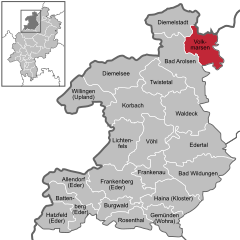Volkmarsen
| Volkmarsen | ||
|---|---|---|
|
||
| Coordinates: 51°23′N 9°7′E / 51.383°N 9.117°ECoordinates: 51°23′N 9°7′E / 51.383°N 9.117°E | ||
| Country | Germany | |
| State | Hesse | |
| Admin. region | Kassel | |
| District | Waldeck-Frankenberg | |
| Government | ||
| • Mayor | Hartmut Linnekugel (Ind.) | |
| Area | ||
| • Total | 67.47 km2 (26.05 sq mi) | |
| Elevation | 259 m (850 ft) | |
| Population (2015-12-31) | ||
| • Total | 6,867 | |
| • Density | 100/km2 (260/sq mi) | |
| Time zone | CET/CEST (UTC+1/+2) | |
| Postal codes | 34471 | |
| Dialling codes | 05693 | |
| Vehicle registration | KB | |
| Website | www.volkmarsen.de | |
Volkmarsen is a small town in Waldeck-Frankenberg district in northern Hesse, Germany.
Volkmarsen lies on the northern edge of the Waldecker Tafel (Waldecker Shield (geology)) where it flattens out into the Diemel Valley, some 28 km northwest of Kassel and 7 km northeast of Bad Arolsen.
Volkmarsen borders in the north on the town of Warburg (Höxter district in North Rhine-Westphalia), in the east on the community of Breuna and the town of Wolfhagen (both in Kassel district), in the south and west on the town of Bad Arolsen and in the northwest on the town of Diemelstadt (both in Waldeck-Frankenberg).
Besides the main town, which bears the same name as the whole, the town of Volkmarsen consists of the centres of Ehringen, Herbsen, Hörle, Külte and Lütersheim.
Volkmarsen's first documentary mention came in 1155. In a safe-conduct from Pope Gregory IX in 1233, Volkmarsen was first described as a town.
The town council's 31 seats are apportioned thus, in accordance with municipal elections held in 2006:
Note: FWG is a citizens' coalition.
Volkmarsen's oldest seal dates from 1272. Like the current coat of arms, it shows two men, but sitting on a bench, the Count of Everstein and the Abbot of Corvey, the town's two overlords at the time. Another seal from the mid 14th century shows the now familiar church with two windows with religious figures in each one, believed to have been the Archbishop of Cologne and once again the Abbot of Corvey, reflecting the new ruling arrangement over the town. The two figures in the arms nowadays, however, are Saint Peter (holding the key) and Saint Paul (holding the sword). This became the arms in the 19th century.[1]
...
Wikipedia




